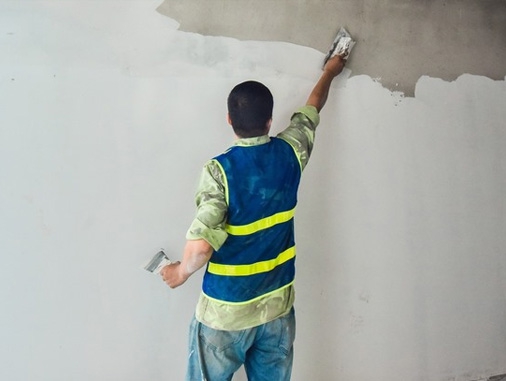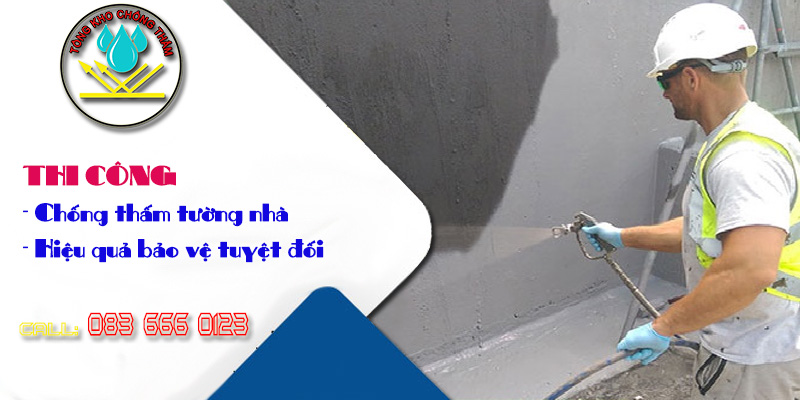
ADVANTAGES
Construction ensures technical standards, absolute waterproofing effect
Using new waterproofing products, suitable for all projects
Professional construction solutions, maximum cost savings for customers
Long-term warranty policy, ensuring comprehensive protection of the project
During the construction of a house, wall waterproofing plays an extremely important role, ensuring that the building will last and be strong over time. Wall waterproofing work is not simply a part of the construction process, but also an essential element to protect the house from the harmful effects of the external environment, especially water infiltration.

The method of wall waterproofing is widely applied on the exterior and interior surfaces of the building walls, with the objective of definitely preventing the penetration of water into the interior. Walls play a key role in protecting a home's structure from damaging elements such as moisture, mold, and damage caused by inclement weather. Therefore, choosing the right wall waterproofing solution is indispensable.
|
Construction of cheap wall waterproofing | Free Quote Quality and sustainability are two important factors that every home needs to ensure. One problem that is often faced is the problem of wall water penetration. Waterproof walls not only cause fungus, mold, and bad aesthetics, but can also damage the wall structure and foundation over time. To solve this problem, KHOCHONGTHAM.COM.VN provides wall waterproofing services with the goal of providing peace of mind and optimal protection for your home. 1. Why choose our house wall waterproofing service? - Prestige and Experience: We provide reputable waterproofing services, owning a team of experienced technicians in the field of waterproofing, ensuring that the job is completed accurately and efficiently. - Professional advice: Our consulting team is always ready to listen and offer the most suitable solutions based on the actual condition of the wall and your needs. - Diversity of options: We use many modern waterproofing methods and quality products to ensure that any cracks and holes in the wall will be repaired in the best way. - Commitment to quality: We are committed to providing you with a durable waterproofing layer, making your walls water resistant and resistant to the effects of time. - Reasonable price: Our wall waterproofing construction service is designed to fit every client's budget. We are committed to providing the best value for your investment. 2. Our wall waterproofing services include: Wall Condition Assessment: Check and assess wall water penetration to determine the scope and extent of the problem. - Planning and design: Based on the assessment, we will plan and design a suitable waterproofing plan. - Waterproofing: Conduct waterproofing by using quality technologies and products. - Inspection and maintenance: Once completed, we will carry out technical inspection and maintenance instructions to ensure the effectiveness of the waterproofing layer in the long run. With our cheap house wall waterproofing construction service, you can be assured of the condition of your home. Contact us today for a free consultation and estimate for your wall waterproofing work. We are committed to providing peace of mind and protection for your home at the best value. |
Popular home wall waterproofing construction plan
There are many popular home wall waterproofing methods that you can choose from depending on the specific situation and requirements of the project. Here are some common options:
1. Waterproof paint
Waterproof paint is a special layer of paint capable of creating a waterproof film on the surface of the wall. Waterproof coatings can contain waterproofing compounds such as acrylic, polyurethane, epoxy, silicone, etc.
2. Waterproof concrete
Using concrete containing waterproofing admixtures can improve the waterproofing ability of the wall surface. Waterproof concrete can be used to construct a waterproofing layer during construction.
3. Waterproof membrane
Use waterproof membranes such as bitumen membrane, PVC film, HDPE film to cover the concrete layer and create a waterproof layer.
4. Waterproof brick
Waterproof brick has the ability to limit water penetration through the wall surface. This type of tile is often used in areas with a high risk of exposure to water, such as bathrooms and toilets.
5. Waterproof glue
Waterproof glue can be applied directly to the wall surface to create a waterproof membrane. Waterproof glue is usually based on epoxy or polyurethane.
6. Waterproof silicone
Use waterproof silicone to close the cracks and prevent between the walls. This helps prevent water from seeping into the crevices and preventing seepage through the wall.
7. Waterproof mortar
Use waterproof mortar containing waterproofing compounds to create a surface screed with good waterproofing ability.
8. Construction of waterproofing system
If you are building a new building, an integrated waterproofing system with layers of waterproofing, membrane and concrete can be used.
9. Handling cracks and crevices
The process of treating and maintaining cracks and crevices in the wall surface is also an important part in preventing seepage through the wall.
What is the professional waterproofing construction process?
Building wall waterproofing is the process of applying measures and materials to prevent the ingress of water into the wall structure, thereby protecting the wall from problems such as mold, damage, and minimizing risk of damage to the base material and the resistance of the wall. Here are the basic steps of a professional waterproofing service:
1. Assess the condition of the wall
Check the condition of the wall to determine the cause of the water seepage problem. It can be caused by cracks, holes, cracks or damage to old paint or waterproofing mortar.
2. Planning and Design
Based on the condition of the wall and the requirements of the building, make a specific plan and design for the waterproofing process. This includes selecting the right waterproofing material, designing the screed and coating, and identifying impervious spots that need to be treated.
3. Surface Preparation
Before starting construction, the wall should be cleaned, degreased and removed from any impurities such as dust, grease or any other material that interferes with the waterproofing process.
4. Repair of cracks and holes
Cracks and holes in the wall should be repaired using waterproofing materials, such as silicone sealant, waterproof mortar, or waterproof adhesive tapes.
5. Apply waterproof layer
Apply the waterproofing layer to the wall surface according to the manufacturer's instructions. Waterproof coatings, waterproofing membranes or other waterproofing materials can be used.
6. Treat areas that need special attention
Areas such as corners, windows, drains, electrical pipes, or brick-and-stone connections need to be treated with care.
7. Quality inspection and control
Upon completion of the application of the waterproofing layer, a thorough inspection should be performed to ensure that the wall is adequately waterproofed and free of weak points.
8. Waterproof test
If necessary, waterproofing tests can be carried out to ensure the effectiveness of the application process.
9. Finishing and maintenance
Once the waterproofing is complete, you need to maintain the walls regularly and check the waterproofing spots to make sure they are still effective.
Note that waterproofing is a professional and highly technical process. If you do not have the experience or knowledge about this, you should find a professional or reputable waterproofing company to do it.
Some popular home wall waterproofing solutions
House walls, especially exterior walls, are often exposed to rain water, leading to corrosion, water infiltration and the production of mold. Failure to handle this situation properly can cause rapid damage to the home, and the risk of fire, explosion, electric shock and unwanted accidents. Therefore, the prevention of wall seepage is urgent, requiring the correct procedure to be followed to ensure the safety and sustainability of the construction. Here are the currently applied wall waterproofing solutions:
1. Wall waterproofing when newly built
During the construction phase, preventing wall penetration from the beginning is the best measure. This requires following these steps:
- In terms of construction techniques:
Conduct research on weather and climate characteristics, accompany architectural designers to propose a scientific construction plan and maximum waterproofing.
Design the roof with a reasonable slope angle to prevent rainwater from affecting the wall and prevent seepage.
Build walls with a minimum thickness of 200-220 mm (size 20) to avoid cracking and seepage.
Ask the contractor to carry out the wall construction according to the correct procedure. Plastering and waterproofing when painting inside and outside walls is essential.
- Regarding the selection of building materials:
Use quality wall tiles, especially solid tiles with better waterproofing ability. ACC autoclaved aerated concrete brick is a good choice for wall waterproofing and insulation.
Use waterproof paint instead of conventional paint.
Incorporating waterproofing admixtures into concrete to increase durability, crack resistance and water penetration.
2. Waterproofing the old house wall
For old walls with water seepage, peeling of concrete surfaces, etc., the following solutions can be applied:
- Rebuild the house wall:
Completely remove old paint and weakly bonded grout by scraping with a wire brush or special brush. Then, fill the cracks with special glue or cement.
In case the wall is too damaged, it is necessary to scrape off the old mortar layer and replace it with a new layer of mortar combined with a waterproofing agent. Cleaning and repainting the wall helps to create a good surface for waterproofing and preventing water from pooling.
- Repaint the wall:
This method is suitable for walls that are still relatively well. Waterproof paint forms a protective film against water penetration from the outside environment.
- Pumping waterproof solution:
The wall is divided into rows and each hole is drilled to pump the waterproofing solution inside. Or you can spray a waterproofing solution on the surface of the wall that has been cleaned. Spraying the solution needs to be done multiple times with an interval of 3-5 hours. After 24 hours, the solution penetrates deep into the wall and can be painted with an external waterproof paint.
3. Waterproofing gaps between adjacent houses
Use corrugated iron grooves along the gap between the walls to collect and discharge rainwater.